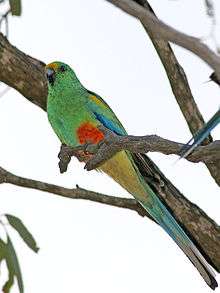Mulga parrot
| Mulga parrot | |
|---|---|
 | |
| A male at Wyperfeld National Park, Victoria, Australia | |
| Scientific classification | |
| Kingdom: | Animalia |
| Phylum: | Chordata |
| Class: | Aves |
| Order: | Psittaciformes |
| Family: | Psittaculidae |
| Genus: | Psephotellus |
| Species: | P. varius |
| Binomial name | |
| Psephotellus varius Clark, 1910 | |
| Synonyms | |
|
Psephotus multicolor | |
The mulga parrot (Psephotellus varius), also known as the many-coloured parrot, is endemic to arid scrublands and lightly timbered grasslands in the interior of southern Australia.[2]
Taxonomy
The mulga parrot was given its current scientific name of Psephotellus varius by American zoologist Austin Hobart Clark in 1910, after its name Psephotus multicolor was ruled invalid as the original combination (Psittacus multicolor) had been used for another species.[3]
In 1955, British evolutionary biologist Arthur Cain reviewed various described subspecies and found none were valid.[4]
Cain concluded in 1955 that within the genus Psephotus the mulga parrot was more closely related to the golden-shouldered parrot than to the red-rumped parrot.[4]
A 2011 genetic study including nuclear and mitochondrial DNA found that the mulga parrot was closely related to the red-capped parrot, the two lineages having diverged in the Miocene. The combined lineage itself diverging from one giving rise to the hooded and golden-shouldered parrots.[5]
John Gould called this bird "many-coloured parakeet" or "many-coloured parrot", a term used during the 19th century. The RAOU proposed "mulga parrot" in 1926.[6] Other common names include various parrot and varied parrot.[7]
Description
The male mulga parrot is multicolored, from which the alternate common name many-coloured parrot is derived. It is a bright green overall, with a bluish tinge on the neck and above the eye, and paler on the breast. The rump is light green. The forehead is yellow and there is a red patch on the back of the head. The lower belly and thighs are yellowish marked with orange-red and the wings greenish apart from the yellow median wing coverts and blue outer webs of primaries. The long tail is an assortment of colours: the two long central feathers are dark blue tinged with green, the outer feathers are blue shading to white and there is some red on the upper tail coverts. Its bill is a blue-grey edged with black, and iris is brown. The female is duller overall, with an olive-brown head and chest, duller yellow forehead and red patch on the back of the head, and pale green belly, and more brown-grey bill. It has a red shoulder.[2][7][8]
Distribution and habitat
The species ranges across the drier interior of the Australian continent, from Western New South Wales from Collarenabri, West Wyalong and Griffith westwards through the northwestern tip of Victoria and across South Australia and into the drier central regions of Western Australia west to the Wheatbelt and north to the Pilbara.[7] The mulga parrot is generally encountered in pairs in arid grassland and mulga scrubland.[8]
Breeding
Breeding season is anywhere from July to December or after rainfall, with one or occasionally two broods raised depending on rainfall. A hollow in a tree is utilised for nesting, and a clutch of four to six white eggs measuring 22 x 18 mm is laid.[9]
References
- ↑ BirdLife International (2012). "Psephotellus varius". IUCN Red List of Threatened Species. Version 2013.2. International Union for Conservation of Nature. Retrieved 26 November 2013.
- 1 2 Stepnell, Kenneth; Boles, Walter. Australia's beautiful birds and their young. Sydney, Australia: Australian Consolidated Press. p. 66. ISBN 0-949892-13-0.
- ↑ "Species Psephotus (Psephotus) varius Clark, 1910". Australian Biological Resources Study: Australian Faunal Directory. Department of the Environment, Water, Heritage and the Arts, Australian Government. 9 October 2008. Retrieved 30 April 2010.
- 1 2 Cain, Arthur J. (1955). "A revision of Trichoglossus hematodus and of the Australian Platycercine parrots". Ibis. 97 (3): 432–79. doi:10.1111/j.1474-919X.1955.tb04978.x.
- ↑ Schweizer, Manuel; Güntert, Marcel; Hertwig, Stefan T. (2012). "Out of the Bassian province: historical biogeography of the Australasian platycercine parrots (Aves, Psittaciformes)". Zoologica Scripta. 42: 13–27. doi:10.1111/j.1463-6409.2012.00561.x.
- ↑ Gray, Jeannie; Fraser, Ian (2013). Australian Bird Names: A Complete Guide. Collingwood, Victoria: Csiro Publishing. p. 141. ISBN 978-0-643-10471-6.
- 1 2 3 Lendon, Alan H. (1973). Australian Parrots in Field and Aviary (2nd ed.). Sydney: Angus and Robertson. pp. 219–23. ISBN 0-207-12424-8.
- 1 2 Forshaw, Joseph M. & Cooper, William T. (1978). Parrots of the World (2nd ed.). Melbourne: Landsdowne Editions. pp. 245–46. ISBN 0-7018-0690-7.
- ↑ Beruldsen, G (2003). Australian Birds: Their Nests and Eggs. Kenmore Hills, Qld: self. p. 250. ISBN 0-646-42798-9.
External links
| Wikimedia Commons has media related to Psephotellus varius. |
